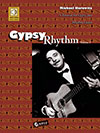Gypsy Rhythm Volume 1 is a book of 280 pages, spiral bound, heavy and, at first sight, rather intimidating. If the sheer volume of the book does not impress you, the volume of audio materials certainly would : the book comes with three Cds. More of then not, a book of this size is often packed with superfluous and irrelevant materials all aimed at alluring you to buy it for its sheer size. But once in a while, and a long while at that, along comes something like Gypsy Rhythm Volume 1.
This book has everything you need to know about Gypsy Jazz rhythm playing. It has a full chord library for the chords used in this genre of music and the book contains a detailed analysis of the use of these chords, the relevant chord progressions and how to get the essence of the rhythm going. You simply cannot go wrong with this book. You will rarely ever see a book that explains something so lucidly, so clearly, in such detail and with such articulation. The author Mr. Michael Horowitz anticipated most of the questions you will be asking and he already has the answers for you in the chapters of the book.
Another highlight of this book is the transcription part. This part of the book contains the transcription of 8 Gypsy Jazz songs. But unlike most books, the transcriptions here are not simply transcription of a recorded version of the song. For each of the songs, the author sets out a basic version, a an intermediate and advanced version of the same song. Some songs even have a transcription for a modern version and a comping version. This is so important as it documents the evolution of the music in terms of voicing and chord changes over time. This helps not only in understand Gypsy Jazz but chord progressions and chord voicing in general. You cannot help but get inspired and you will obtain a good insight if you have the patience to go through the different versions of the transcription.
Those who know little will always look to playing guitar solos to the exclusion of everything else. But it is the rhythm parts, the chord progression that provide the basis and foundation for the guitar solo. Knowing your chords and mastering the rhythm guitar is the key to playing great guitar solos. And Gypsy Rhythm Volume 1 is the book that will help you master it. And what is in the book applies not only to Gypsy Jazz; most of the materials therein have universal application.
If you want to pick up a few flashy things to impress your friends and fans, this is not the book. But if you want to really understand Gypsy Jazz rhythm and rhythm guitar in general, this is the one book I will buy if I was allowed to buy only one book.
Just one complaint : where is Gypsy Rhythm Volume 2 ? And Volume 3 ? Well, all is not lost. Mr. Horowitz tells me that Gypsy Rhythm Volume 2 should be available around early 2013. I just cannot wait.
Submitted by: Allblues on 05/16/2012 12:09:44 AM
 DjangoBooks
Book/Audio set. Become a one man swing rhythm section by learning the accompaniment secrets of Gypsy jazz legends Django Reinhardt, Stochelo Rosenberg, Bireli Lagrene, and more! 296 p. Includes over 200 Audio examples!
Arts & Entertainment
michael-horowitz-gyspy-rhythm-volume-1
1000
4.8
18
DjangoBooks
Book/Audio set. Become a one man swing rhythm section by learning the accompaniment secrets of Gypsy jazz legends Django Reinhardt, Stochelo Rosenberg, Bireli Lagrene, and more! 296 p. Includes over 200 Audio examples!
Arts & Entertainment
michael-horowitz-gyspy-rhythm-volume-1
1000
4.8
18










